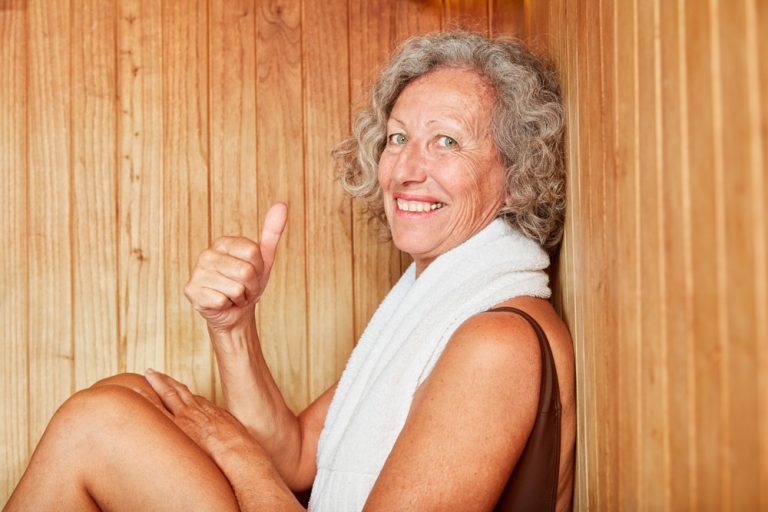
Feeling the cold? Why not jump in a sauna and experience the boost that heat therapy can give to your body and mood. Humans have been enjoying sauna health benefits for thousands of years. The first saunas are thought to have originated in northern Europe around 2,000 B.C., and they’re still an important part of life and culture in countries such as Russia, Turkey, Estonia and Finland.
Sweating it out in a sauna has been claimed to detoxify the body, increase metabolism, assist with weight loss and rejuvenate the skin. While some of these claims are unsupported, there is research that sauna health benefits include a positive impact on our circulatory, cardiovascular and immune systems.
How do saunas work?
Sauna bathing is a form of whole-body heat therapy where you’re exposed to a high temperature for a short period of time. A sauna is typically a small room with plain wood floors and walls, and wooden seating positioned above the floor.
Saunas can use a dry heat or damp heat: Finnish-style saunas are dry, while Turkish-style saunas are steamy. Dry saunas sometimes include a heater with rocks that absorb and give off heat. Water can be poured on to the rocks to create steam and increase the heat and humidity.
Temperatures in a sauna range between 150 to 195 degrees Fahrenheit. A bather would normally intersperse a brief time inside the sauna, usually 5 to 20 minutes, with a cooling off period spent sitting outside or in a shower or swimming pool.
Sauna health benefits
An extensive study published by the Mayo Clinic listed sauna health benefits such as reduced vascular disease, high blood pressure and heart disease. Because the heat of the sauna dilates blood vessels and stimulates circulation, it’s thought to reduce arterial stiffness, improve the lipid composition of our blood and stabilize resting blood pressure. It’s also been linked to improving certain skin conditions, and to helping manage pain for arthritis and headaches.
In a Finnish study, frequent sauna users were found to have greater protection against heart disease and live longer. The results suggested that sauna bathing improved the function of blood vessels and increased blood flow to the brain, lowering the risk of developing dementia such as Parkinson’s.
Other researchers believe that sauna health benefits stem from the body responding to the effect of whole-body heat the same way it reacts to moderate- or high-intensity physical activity. We sweat, our heart rate and core temperature go up, and blood moves more rapidly through our body. While this isn’t the same as working out in the gym or going for a brisk walk, it does share similar benefits such as guarding against inflammation and maintaining muscle mass.
Tips for Sauna Bathing
The sauna is intended as a pleasant place to relax and let go of stress. Give yourself a reasonable amount of time inside. Avoid a heavy meal or alcohol before using the sauna. It’s OK to keep a towel wrapped around you if you prefer not to be completely bare during a sauna session.
- Rinse off in the shower before entering the sauna.
- Check that the temperature is set to your preference. If you’re new to sauna bathing, start with a lower temperature, or stay inside for shorter periods.
- Place a small towel where you intend to sit to protect your skin from the hot surface.
- Increase the humidity and heat by throwing water on the sauna heater.
- Stay inside the sauna for as long as you feel comfortable.
- After perspiring for a few minutes, leave to refresh yourself with a shower or a cool swim.
- If you have a heart condition or high blood pressure, don’t shock your body with extreme cold after being in the hot room.
- Repeat the heating and cooling process as many times as you wish. Most people go for at least two sessions in the hot room.
- Bathe yourself normally with soap and shampoo after your last session.
- Wait until your temperature has normalized and you’ve stopped perspiring to get dressed.
- It’s normal to feel thirsty and hungry after a sauna. Restore fluids by drinking plenty of water and have a light snack or meal.
Is Sauna Good for Seniors?
If you’ve always used a sauna regularly, you can continue the habit right up into your later years. Older adults who’ve never used a sauna before can begin to do so, but should consult their doctor first, especially if they’re being treated for an unstable heart condition or an illness. Be aware that sauna bathing may aggravate certain skin conditions and the heat may irritate your nose and throat, making it hard to breathe.
You’ll sweat a lot. Make sure you’re well hydrated and avoid drinking alcohol prior to using a sauna. Take a bottle of water or an electrolyte drink to sip when you feel thirsty. Resist the urge to compete with others by staying as long, or longer than they are, and instead pay attention to how you feel. Step outside to cool down at the first sign of dizziness or lightheadedness.
Looking for a Sauna Near You?
Look no further. As part of our luxurious expansion, Fellowship Village will offer a state-of-the-art fitness center with a variety of the latest exercise equipment, club locker rooms and a sauna. Everything you need is provided, including fresh towels, bottled water and, of course, instructions if you’ve never used a sauna before. Once you’re finished with your sweat session, head over to our newest 5-star restaurant, Wilson’s Tapas Bar. It’s the perfect place to relax in the warm afterglow while you fill up on delicious tapas items and a refreshing beverage. Contact us to explore what our expansion offers.




